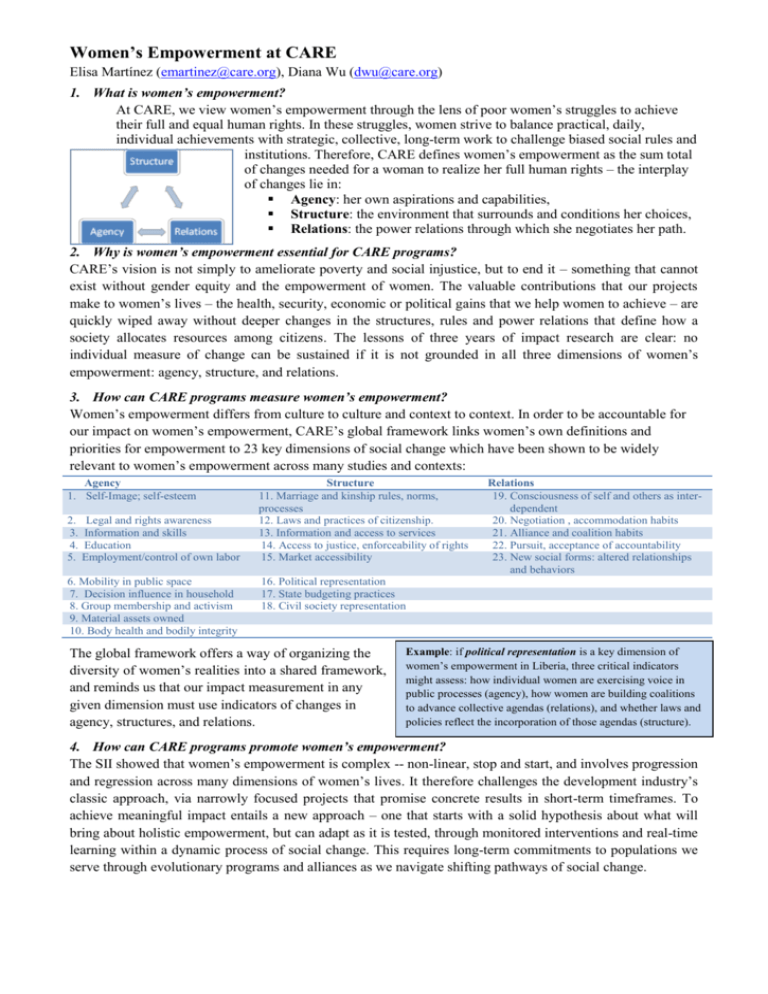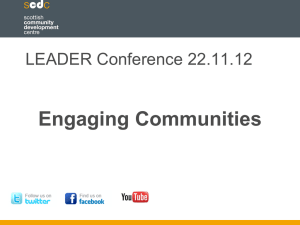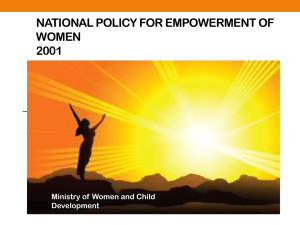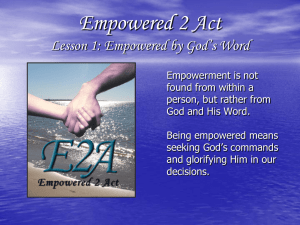SII Women`s Empowerment Framework 1 page
advertisement

Women’s Empowerment at CARE Elisa Martínez (emartinez@care.org), Diana Wu (dwu@care.org) 1. What is women’s empowerment? At CARE, we view women’s empowerment through the lens of poor women’s struggles to achieve their full and equal human rights. In these struggles, women strive to balance practical, daily, individual achievements with strategic, collective, long-term work to challenge biased social rules and institutions. Therefore, CARE defines women’s empowerment as the sum total of changes needed for a woman to realize her full human rights – the interplay of changes lie in: Agency: her own aspirations and capabilities, Structure: the environment that surrounds and conditions her choices, Relations: the power relations through which she negotiates her path. 2. Why is women’s empowerment essential for CARE programs? CARE’s vision is not simply to ameliorate poverty and social injustice, but to end it – something that cannot exist without gender equity and the empowerment of women. The valuable contributions that our projects make to women’s lives – the health, security, economic or political gains that we help women to achieve – are quickly wiped away without deeper changes in the structures, rules and power relations that define how a society allocates resources among citizens. The lessons of three years of impact research are clear: no individual measure of change can be sustained if it is not grounded in all three dimensions of women’s empowerment: agency, structure, and relations. 3. How can CARE programs measure women’s empowerment? Women’s empowerment differs from culture to culture and context to context. In order to be accountable for our impact on women’s empowerment, CARE’s global framework links women’s own definitions and priorities for empowerment to 23 key dimensions of social change which have been shown to be widely relevant to women’s empowerment across many studies and contexts: Agency 1. Self-Image; self-esteem 2. 3. 4. 5. Legal and rights awareness Information and skills Education Employment/control of own labor 6. Mobility in public space 7. Decision influence in household 8. Group membership and activism 9. Material assets owned 10. Body health and bodily integrity Structure 11. Marriage and kinship rules, norms, processes 12. Laws and practices of citizenship. 13. Information and access to services 14. Access to justice, enforceability of rights 15. Market accessibility Relations 19. Consciousness of self and others as interdependent 20. Negotiation , accommodation habits 21. Alliance and coalition habits 22. Pursuit, acceptance of accountability 23. New social forms: altered relationships and behaviors 16. Political representation 17. State budgeting practices 18. Civil society representation The global framework offers a way of organizing the diversity of women’s realities into a shared framework, and reminds us that our impact measurement in any given dimension must use indicators of changes in agency, structures, and relations. Example: if political representation is a key dimension of women’s empowerment in Liberia, three critical indicators might assess: how individual women are exercising voice in public processes (agency), how women are building coalitions to advance collective agendas (relations), and whether laws and policies reflect the incorporation of those agendas (structure). 4. How can CARE programs promote women’s empowerment? The SII showed that women’s empowerment is complex -- non-linear, stop and start, and involves progression and regression across many dimensions of women’s lives. It therefore challenges the development industry’s classic approach, via narrowly focused projects that promise concrete results in short-term timeframes. To achieve meaningful impact entails a new approach – one that starts with a solid hypothesis about what will bring about holistic empowerment, but can adapt as it is tested, through monitored interventions and real-time learning within a dynamic process of social change. This requires long-term commitments to populations we serve through evolutionary programs and alliances as we navigate shifting pathways of social change.








